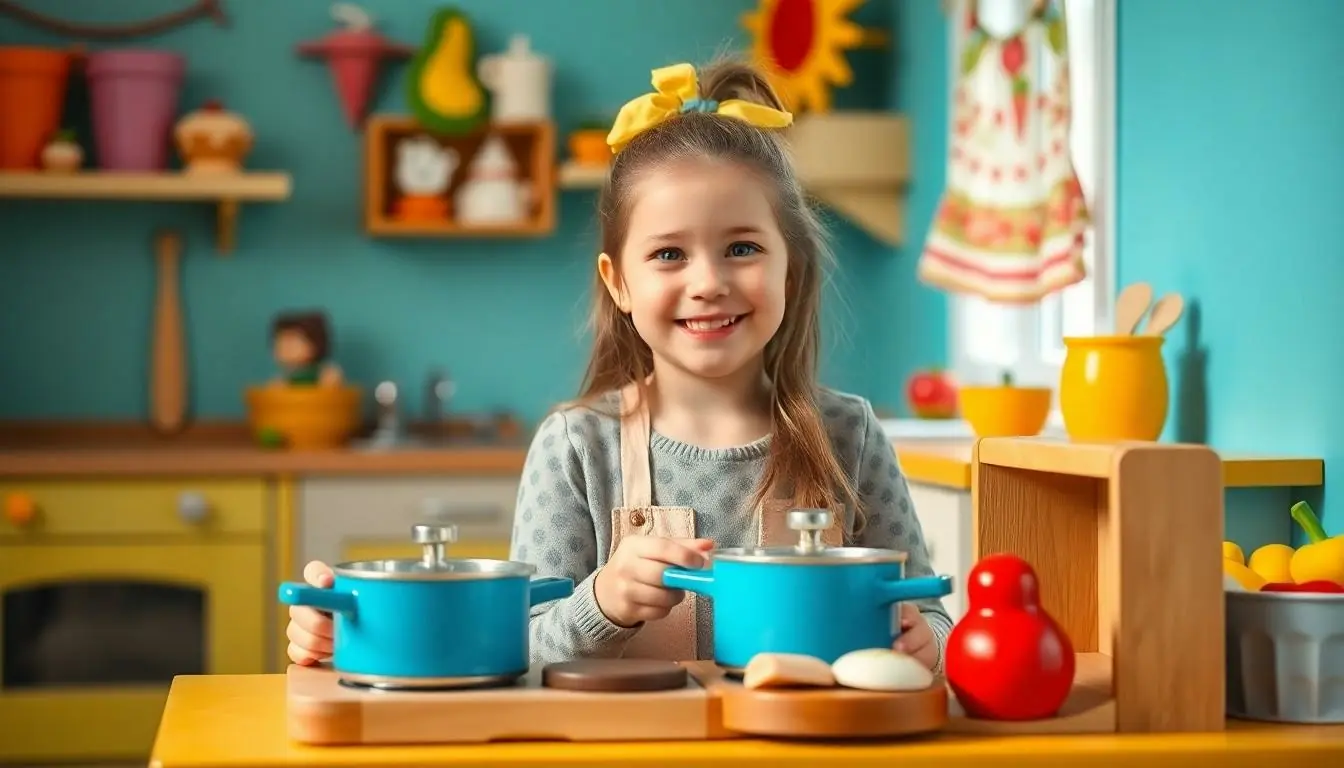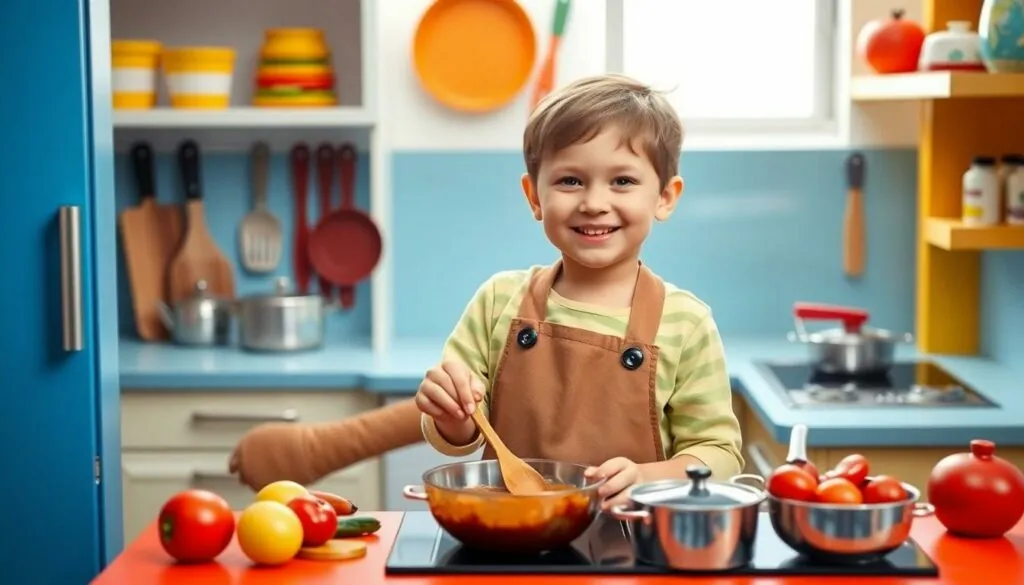Imagine a world where tiny chefs whip up gourmet meals without the risk of burning the house down. Cooking toys for kids turn kitchen antics into delightful playtime adventures, sparking creativity and culinary curiosity. These playful gadgets not only keep little hands busy but also teach essential skills like measuring, mixing, and maybe even how to avoid a kitchen disaster (like that time Dad tried to make pancakes).
From colorful play kitchens to realistic cooking sets, these toys offer endless opportunities for imaginative role-play. They transform the kitchen into a bustling restaurant where kids can serve up their wildest food fantasies. Plus, who wouldn’t want to see their child don an apron and chef hat, ready to create the next culinary masterpiece? Cooking toys are more than just toys; they’re a recipe for fun, learning, and laughter in every household.
Table of Contents
ToggleOverview of Cooking Toys for Kids
Cooking toys for kids transform kitchen play into engaging learning experiences. These toys encourage creativity and imagination while introducing children to basic cooking concepts.
Benefits of Cooking Toys
Cooking toys enhance fine motor skills through the manipulation of various tools. Role-playing fosters social skills, as children often collaborate in groups. Cognitive development occurs as kids follow recipes and engage in problem-solving. Confidence builds as they successfully create pretend meals, sparking a love for cooking. Educational value stems from introducing food science, nutrition, and culture through imaginative play.
Types of Cooking Toys Available
A variety of cooking toys caters to different interests and age groups. Kitchen sets include realistic tools and appliances, such as stoves and ovens. Play food items offer variety, featuring fruits, vegetables, and baked goods. Baking sets enable children to mimic their favorite dessert recipes. Miniature cookware, including pots and pans, encourages imaginative scenarios. Themed kits, like pizza-making or sushi sets, introduce specific cuisines. Each type contributes to a well-rounded cooking experience during playtime.
Top Cooking Toys for Kids

Various cooking toys engage children in creative play while teaching essential kitchen skills. Exploring different options can enhance their culinary experience.
Wooden Cooking Sets
Wooden cooking sets offer durability and a tactile experience for kids. These sets often include colorful utensils, pots, and play food items crafted from quality wood. Many brands focus on safety, painting pieces with non-toxic finishes. Playing with these sets fosters imaginative role-play and enhances fine motor skills. Children can mimic real cooking scenarios, combining creativity with learning. They can also learn the importance of food presentation as they arrange play meals. Engaging in pretend cooking nurtures social skills as children play together.
Plastic Cooking Sets
Plastic cooking sets provide versatility and a lightweight option for young chefs. Numerous sets include pots, pans, knives, and a variety of pretend food items designed for interactive fun. Most are easy to clean, making them ideal for frequent use. Bright colors and unique designs attract children’s attention and ignite their interest in cooking. These toys encourage exploration of different cuisines and cultures. Sharing these sets among peers enhances cooperation and communication skills. Many brands incorporate realistic sounds and lights, adding excitement to playtime.
How Cooking Toys Promote Learning
Cooking toys offer engaging ways for children to learn while playing. These toys support various developmental areas, making playtime both fun and educational.
Enhancing Motor Skills
Fine motor skills flourish when kids use cooking toys. They grip, cut, and mix play food items, developing dexterity and hand strength. Additionally, fitting pieces into their respective slots enhances coordination. Using utensils like mini spatulas or whisks provides further practice in control and accuracy. Tasks such as pouring pretend ingredients into bowls help refine these essential skills. Tasks often require kids to manipulate small parts, leading to improved precision in their movements. Overall, cooking toys create opportunities for hands-on experiences that strengthen these skills.
Encouraging Imagination and Creativity
Imaginative play thrives with cooking toys. They allow kids to create unique recipes and explore various cuisines without boundaries. Role-playing as chefs or restaurant owners sparks creativity while fostering storytelling abilities. Children often invent scenarios, expanding their problem-solving skills and critical thinking. Cooking toys enable exploration of different cultural foods, introducing diversity in a straightforward manner. The interactive nature of these toys encourages collaboration, as kids often play together, sharing ideas and creations. They craft meals together, enhancing their social skills while having fun.
Safety Considerations
Safety remains a top priority when choosing cooking toys for kids. Parents should carefully consider the age appropriateness and materials used in these toys.
Age-Appropriate Toys
Choosing age-appropriate cooking toys ensures a safe and enjoyable experience. Toys designed for toddlers include soft materials and simple tools that promote exploration without risk. Preschoolers benefit from toys that offer more complex interactions, like utensils and realistic kitchen sets, still adhering to safety guidelines. Older children may enjoy more advanced cooking sets that challenge their skills, fostering independence while ensuring supervision remains a priority.
Material Safety Standards
Material safety standards play a crucial role in children’s toys market. Toys should comply with guidelines set by organizations such as the Consumer Product Safety Commission. Non-toxic plastics and BPA-free materials enhance safety, reducing risks associated with harmful chemicals. The use of sturdy materials like wood ensures durability while providing a tactile experience. Labels indicating certifications and compliance with safety regulations help parents make informed choices. Selecting cooking toys that adhere to these standards allows children to enjoy their culinary adventures safely.
Cooking toys for kids offer a unique blend of fun and education that enriches playtime. By engaging in pretend cooking, children not only explore their creativity but also develop essential skills that will benefit them in the kitchen and beyond. These toys foster collaboration and social interaction, making cooking a shared adventure.
Choosing the right cooking toys ensures that children enjoy safe and enriching experiences. With a variety of options available, parents can find the perfect sets that align with their child’s interests and developmental stage. Embracing the world of cooking toys opens the door to a lifelong love of culinary exploration.




